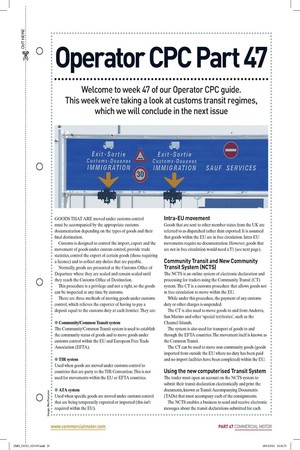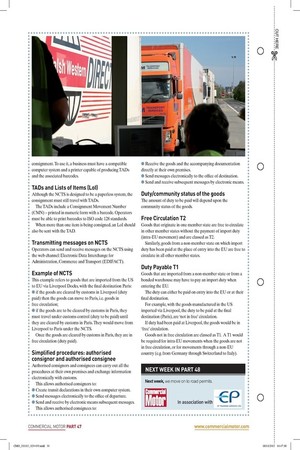Operator CPC Part 47
Page 20

Page 21

If you've noticed an error in this article please click here to report it so we can fix it.
Welcome to week 47 of our Operator CPC guide. This week were taking a look at customs transit regimes, which we will conclude in the next issue
GOODS THAT ARE moved under customs control must be accompanied by the appropriate customs documentation depending on the types of goods and their final destination.
Customs is designed to control the import, export and the movement of goods under custom control, provide trade statistics, control the export of certain goods (those requiring a licence) and to collect any duties that are payable.
Normally, goods are presented at the Customs Office of Departure where they are sealed and remain sealed until they reach the Customs Office of Destination.
This procedure is a privilege and not a right, so the goods can be inspected at any time by customs. There are three methods of moving goods under customs control, which relieves the exporter of having to pay a deposit equal to the customs duty at each frontier. They are: • Conununity/Conunon Transit system
The Community/Common Transit system is used to establish the community status of goods and to move goods under customs control within the EU and European Free Trade Association (EFTA). • TIR system
Used when goods are moved under customs control to countries that are party to the TIR Convention. This is not used for movements within the EU or EFTA countries. • ATA system
Used when specific goods are moved under customs control that are being temporarily exported or imported (this isn't required within the EU). Intra-EU movement
Goods that are sent to other member states from the UK are referred to as dispatched rather than exported. It is assumed that goods within the EU are in free circulation. Intra-EU movements require no documentation. However, goods that are not in free circulation would need a Ti (see next page). Community Transit and New Community Transit System (NCTS)
The NCTS is an online system of electronic declaration and processing for traders using the Community Transit (CT) system. The CT is a customs procedure that allows goods not in free circulation to move within the EU.
While under this procedure, the payment of any customs duty or other charges is suspended.
The CT is also used to move goods to and from Andorra, San Marino and other 'special territories', such as the Channel Islands.
The system is also used for transport of goods to and through the EFTA countries. The movement itself is known as the Common Transit.
The CT can be used to move non-community goods (goods imported from outside the EU where no duty has been paid and no import facilities have been completed) within the EU. Using the new computerised Transit System
The trader must open an account on the NCTS system to submit their transit declaration electronically and print the documents, known as Transit Accompanying Documents (TADs) that must accompany each of the consignments. The NCTS enables a business to send and receive electronic messages about the transit declarations submitted for each
consignment. To use it, a business must have a compatible computer system and a printer capable of producing TADs and the associated barcodes. TADs and Lists of Items (Lol)
Although the NCTS is designed to be a paperless system, the consignment must still travel with TADs.
The TADs include a Consignment Movement Number (CMN) — printed in numeric form with a barcode. Operators must be able to print barcodes to ISO code 128 standards.
When more than one item is being consigned, an LoI should also be sent with the TAD. Transmitting messages on NCTS
Operators can send and receive messages on the NCTS using the web channel: Electronic Data Interchange for Administration, Commerce and Transport (EDIFACT). Example of NCTS This example refers to goods that are imported from the US to EU via Liverpool Docks, with the final destination Paris: • if the goods are cleared by customs in Liverpool (duty paid) then the goods can move to Paris, i.e. goods in free circulation;
• if the goods are to be cleared by customs in Paris, they must travel under customs control (duty to be paid) until they are cleared by customs in Paris. They would move from Liverpool to Paris under the NCTS.
Once the goods are cleared by customs in Paris, they are in free circulation (duty paid). Simplified procedures: authorised consignor and authorised consignee
Authorised consignors and consignees can carry out all the procedures at their own premises and exchange information electronically with customs. This allows authorised consignors to:
• Create transit declarations in their own computer system.
• Send messages electronically to the office of departure. • Send and receive by electronic means subsequent messages. This allows authorised consignees to:
• Receive the goods and the accompanying documentation directly at their own premises.
• Send messages electronically to the office of destination.
• Send and receive subsequent messages by electronic means. Duty/community status of the goods
The amount of duty to be paid will depend upon the community status of the goods. Free Circulation T2
Goods that originate in one member state are free to circulate in other member states without the payment of import duty (intra-EU movement) and are classed as T2.
Similarly, goods from a non-member state on which import duty has been paid at the place of entry into the EU are free to circulate in all other member states. Duty Payable T1
Goods that are imported from a non-member state or from a bonded warehouse may have to pay an import duty when entering the EU.
The duty can either be paid on entry into the EU or at their final destination.
For example, with the goods manufactured in the US imported via Liverpool, the duty to be paid at the final destination (Paris), are 'not in free' circulation.
If duty had been paid at Liverpool, the goods would be in 'free' circulation.
Goods not in free circulation are classed as Ti. A Ti would be required for intra-EU movements when the goods are not in free circulation, or for movements through a non-EU country (e.g. from Germany through Switzerland to Italy).






































